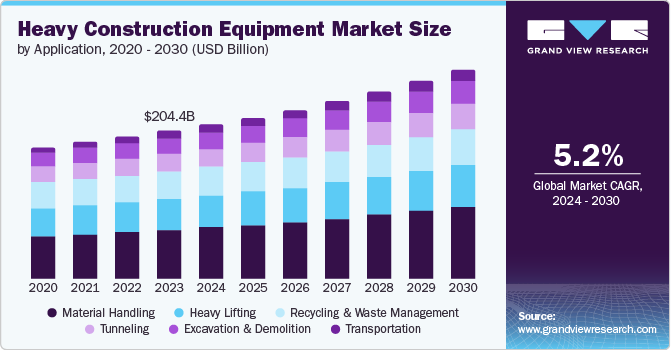The global heavy construction equipment market was valued at approximately USD 204.41 billion in 2023 and is expected to grow at a compound annual growth rate (CAGR) of 5.2% from 2024 to 2030. This growth is primarily driven by ongoing urbanization, an increasing population that heightens the demand for housing solutions, and continuous infrastructure improvements in developing nations. Additionally, the rise of fuel-efficient machinery and the growing trend of high-rise building construction in developed countries are anticipated to boost demand for heavy construction equipment.
The increasing adoption of artificial intelligence (AI) and automation within the construction sector is prompting major companies to integrate advanced technologies into their machinery, further fueling demand. For example, in March 2024, Komatsu Ltd., a leading player in the industry, reported that the commercial deployment of the Komatsu FrontRunner, an Autonomous Haulage System (AHS) truck, surpassed 700 units sold by February 2024. Furthermore, the growing preference for renting or leasing construction equipment, driven by rising machinery and maintenance costs, along with benefits like leasing companies providing necessary professional staff and drivers, is expected to significantly enhance market growth during the forecast period.
Gather more insights about the market drivers, restrains and growth of the Heavy Construction Equipment Market
Application Insights
In 2023, the material handling segment emerged as the dominant revenue generator within the heavy construction equipment market. This segment is critical for various applications that require the movement and management of materials in construction projects, warehouses, and other operational settings. Key equipment in this category includes hoists, conveyors, cranes, forklift trucks, tractors, and dump trucks, all of which play vital roles in facilitating the smooth and efficient transport of bulk materials. These machines are engineered to navigate the complexities of construction sites, which often involve uneven terrain, tight spaces, and intricate layouts, making them indispensable for enhancing productivity and safety.
The effectiveness of material handling equipment lies in its ability to streamline operations, reducing the time and labor required to move materials. This is particularly important in large-scale construction projects where timely delivery of materials can significantly impact project timelines and costs. As manufacturers continue to innovate, there is a growing emphasis on developing user-friendly and technologically advanced equipment that meets the diverse needs of the market. Features such as automation, advanced safety systems, and ergonomic designs are becoming increasingly common, enhancing the operational efficiency of this machinery. As a result, the material handling segment is anticipated to experience significant growth driven by these advancements and the ongoing demand for improved efficiency in construction operations.
On the other hand, the transportation segment is forecasted to achieve the highest compound annual growth rate (CAGR) throughout the forecast period. This anticipated growth is largely fueled by the increasing availability of various types and sizes of heavy motor vehicles, specifically designed for the transportation of heavy materials. The construction sector is witnessing a substantial rise in both road and railway infrastructure projects, creating a pressing need for equipment capable of moving substantial quantities of materials from suppliers to construction sites. Equipment such as dump trucks, which come in various sizes to accommodate different load capacities, as well as haulers, are crucial in this regard.
Moreover, the transportation segment is not limited to just moving construction materials. Heavy construction equipment also plays an essential role in the transportation of liquids, gases, and waste materials along public roadways and highways. This versatility makes heavy construction vehicles integral not only to construction projects but also to broader logistics and waste management operations. As urbanization continues to expand, the demand for efficient transportation solutions is expected to rise, further driving growth in this segment.
Order a free sample PDF of the Heavy Construction Equipment Market Intelligence Study, published by Grand View Research.


